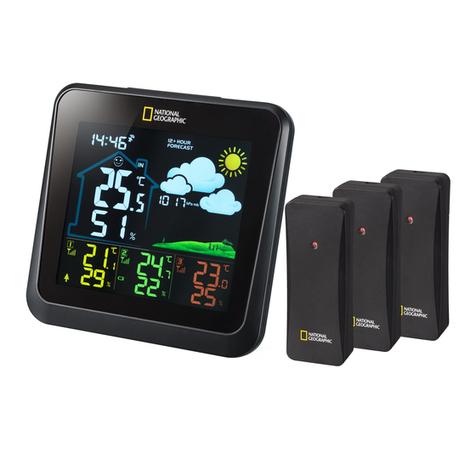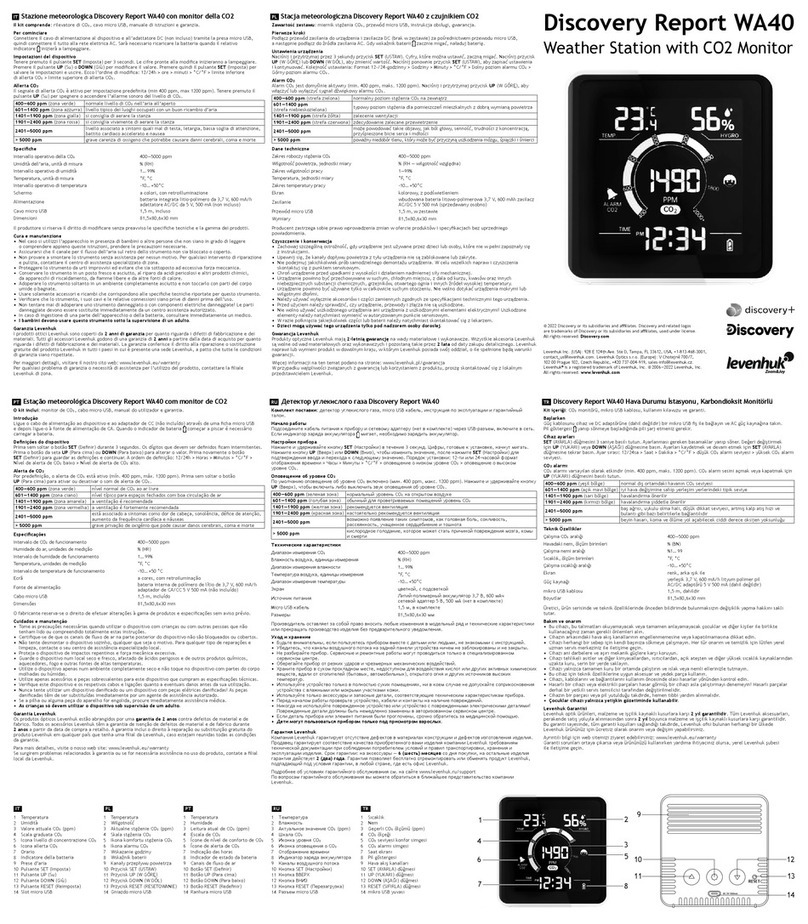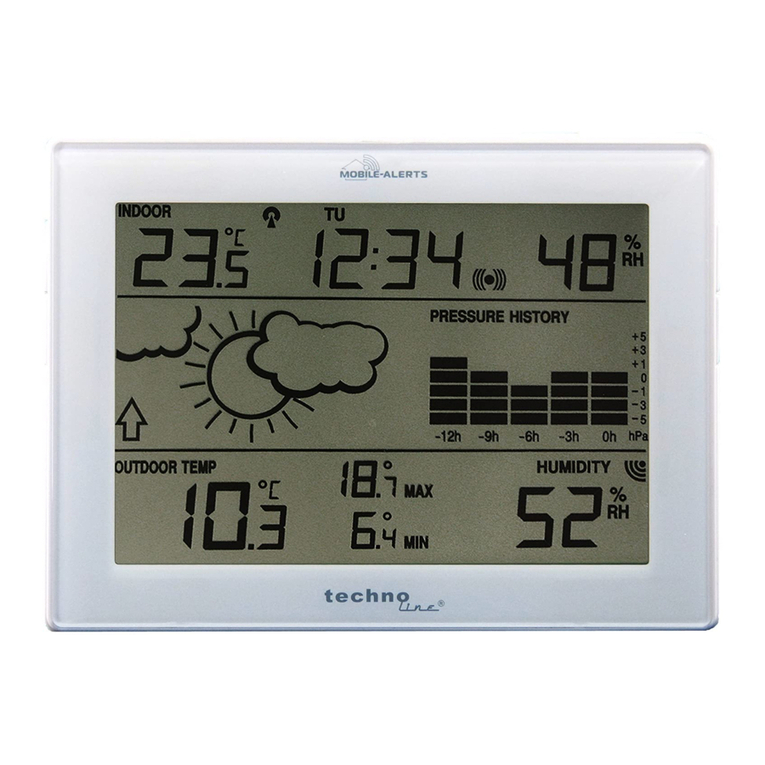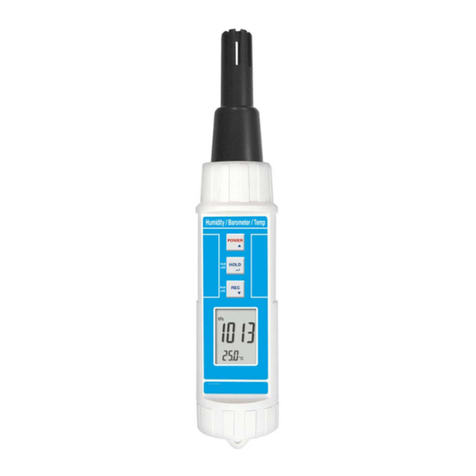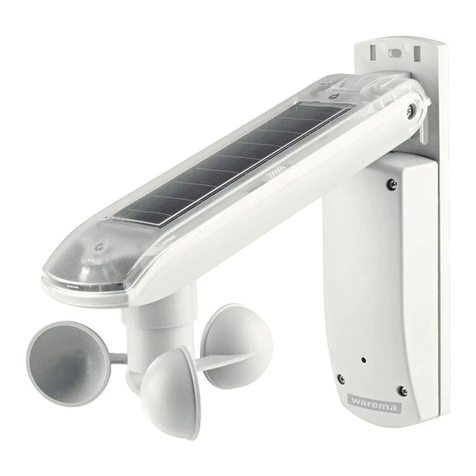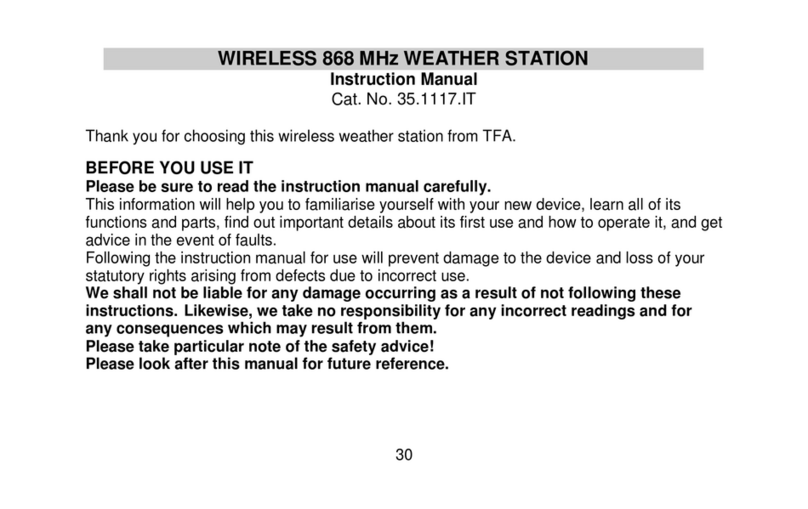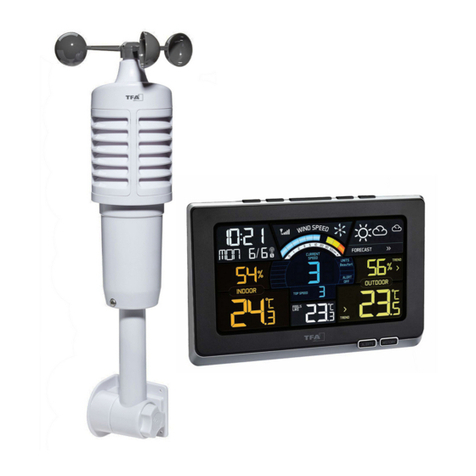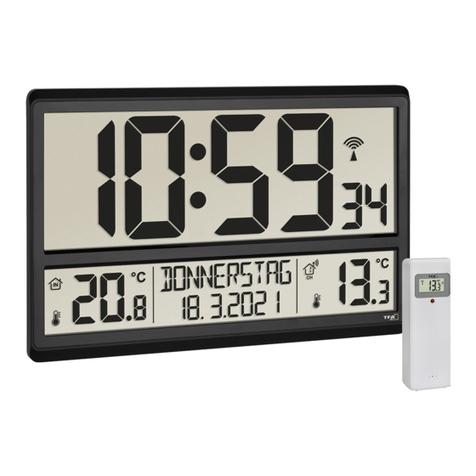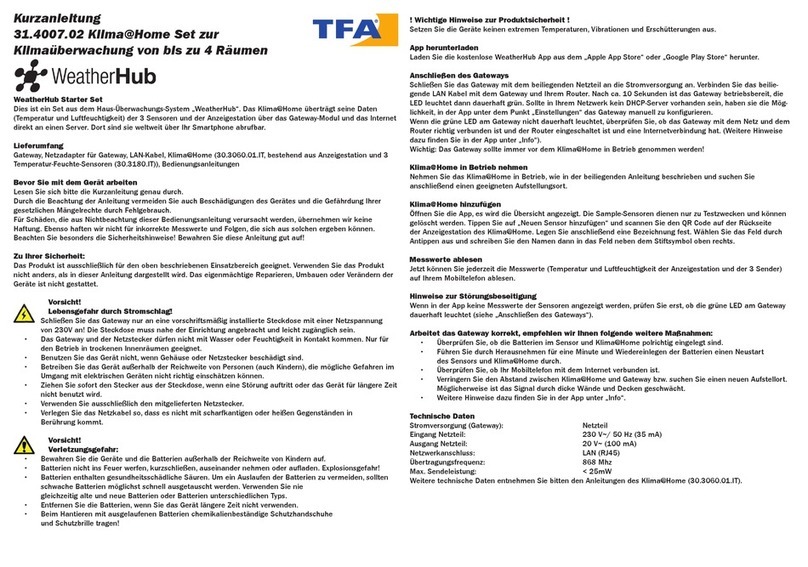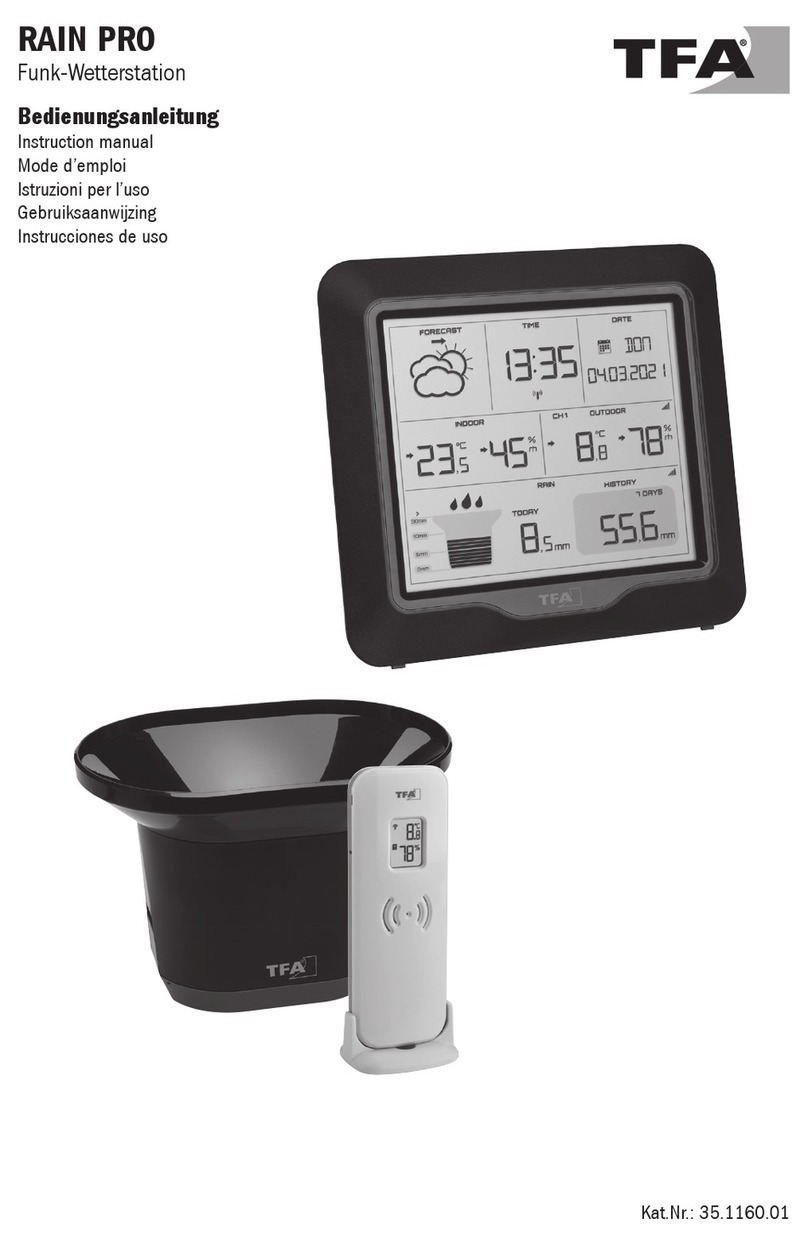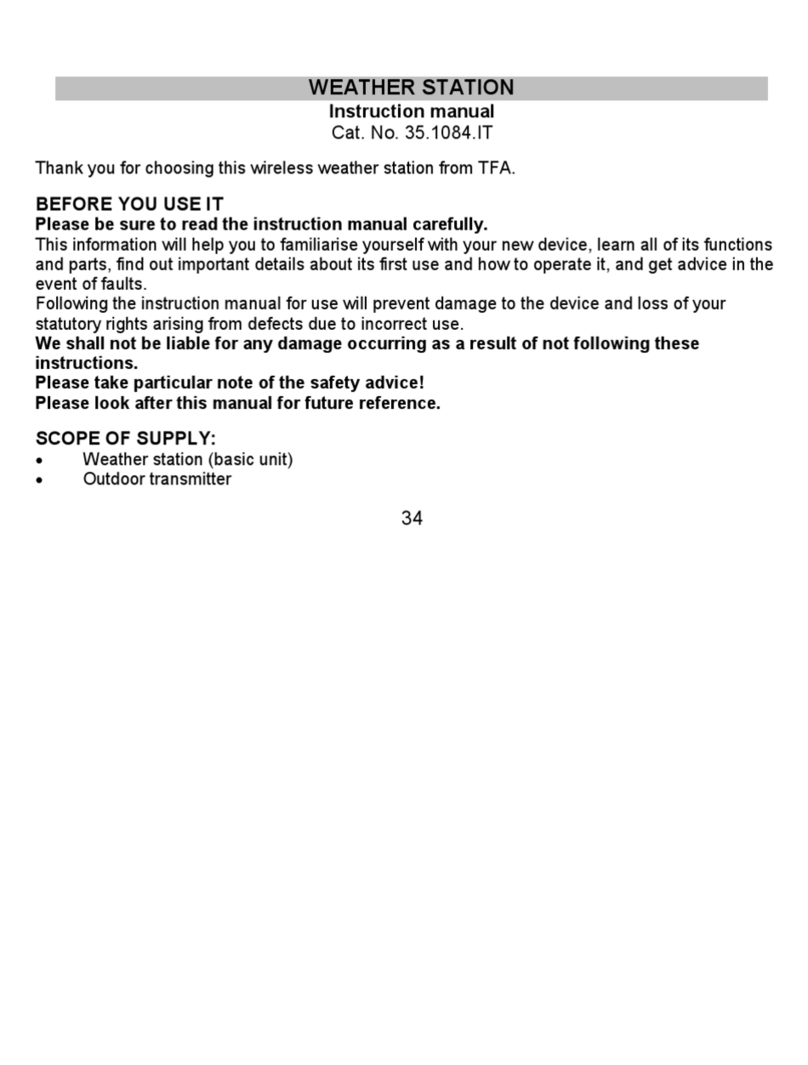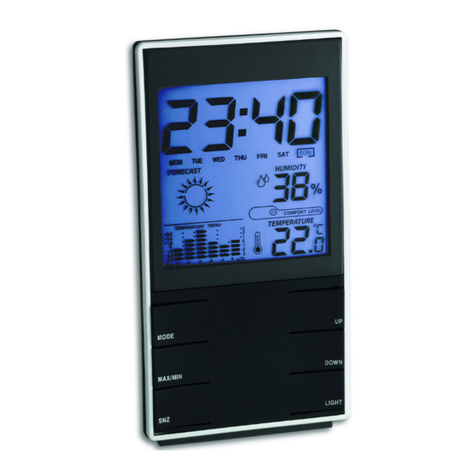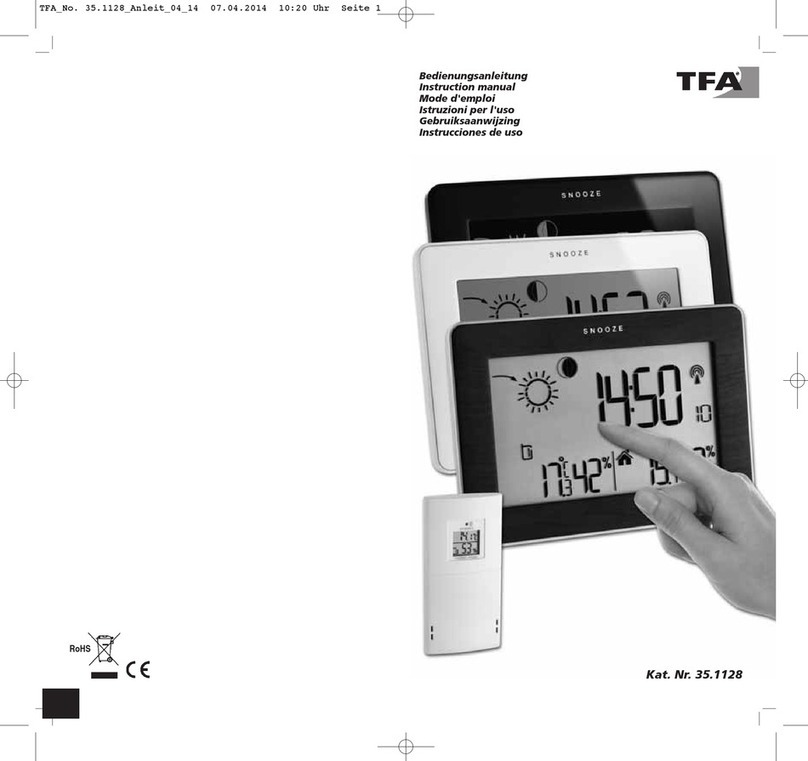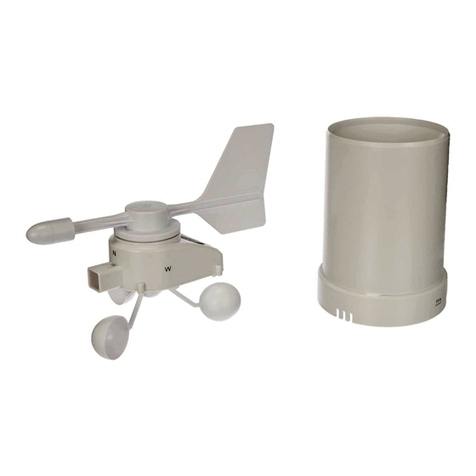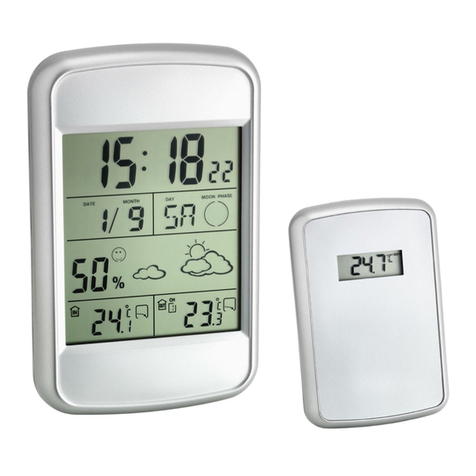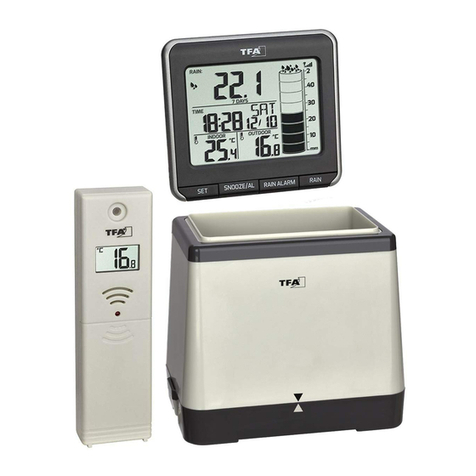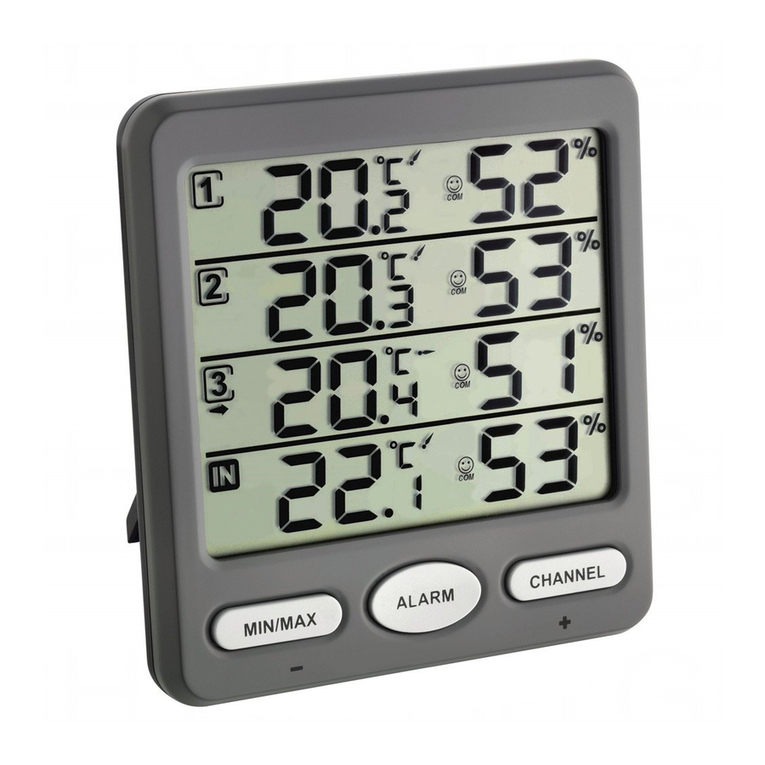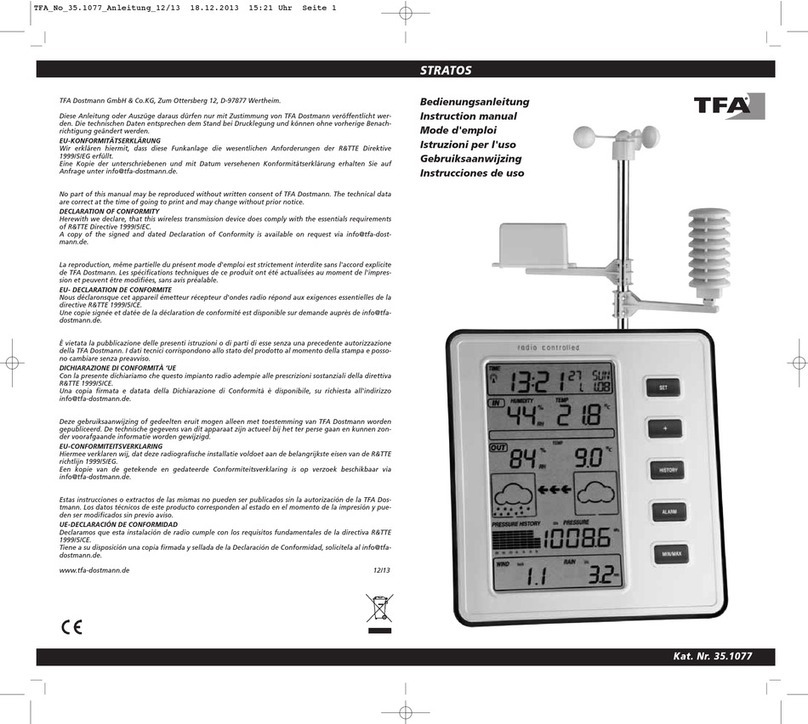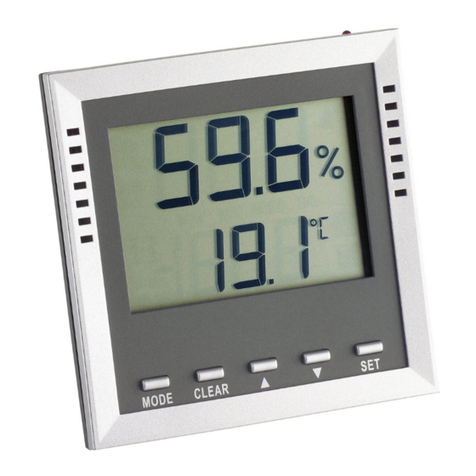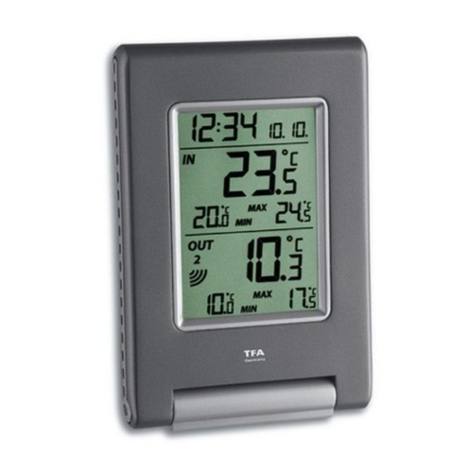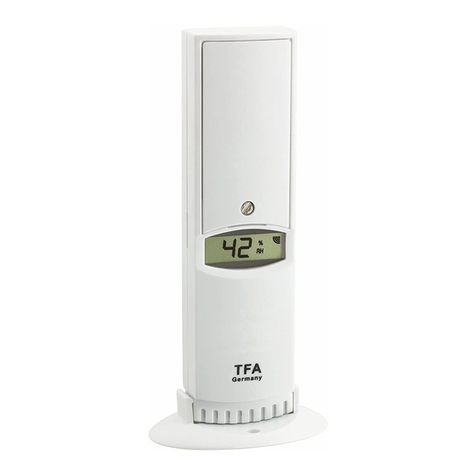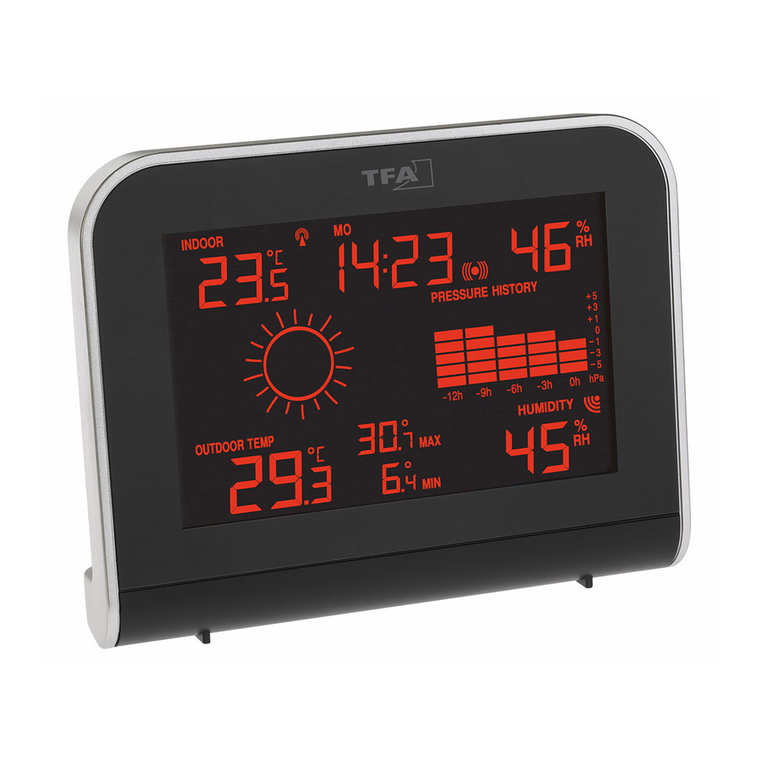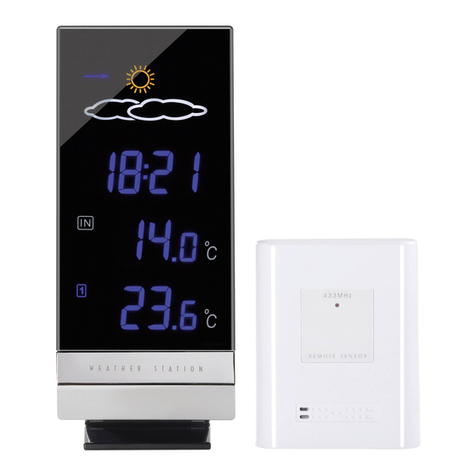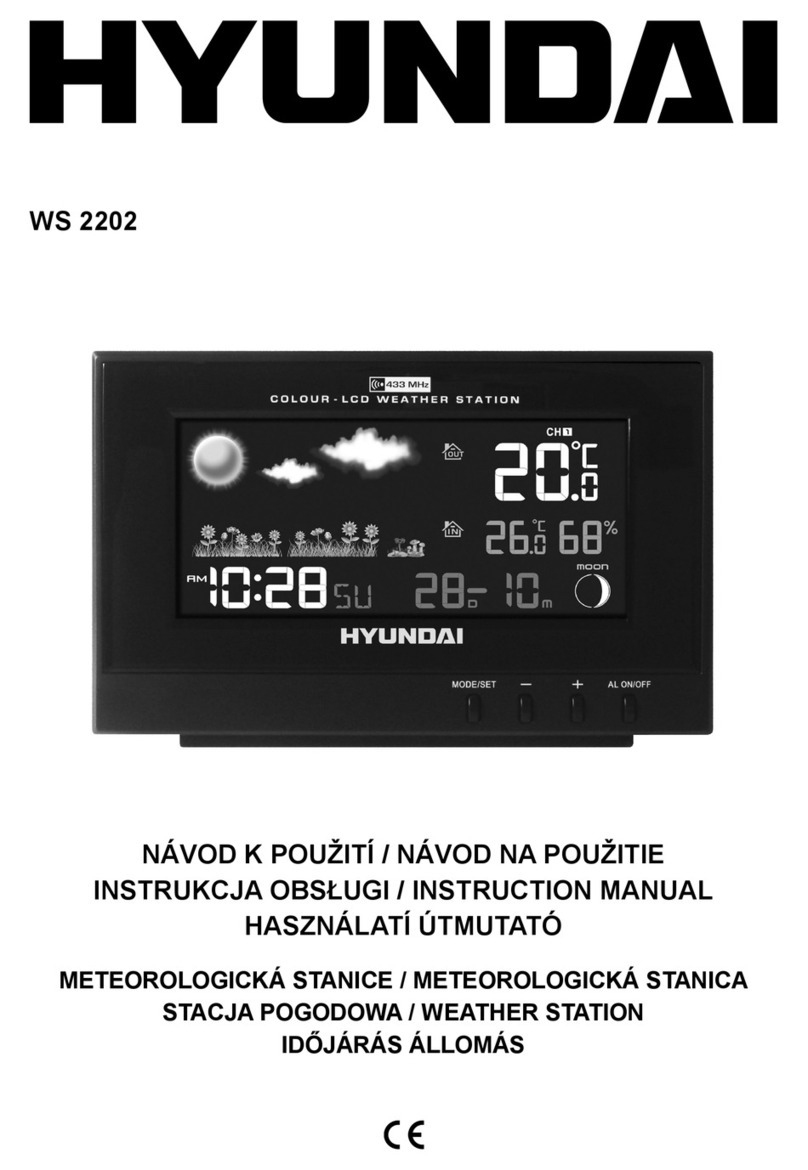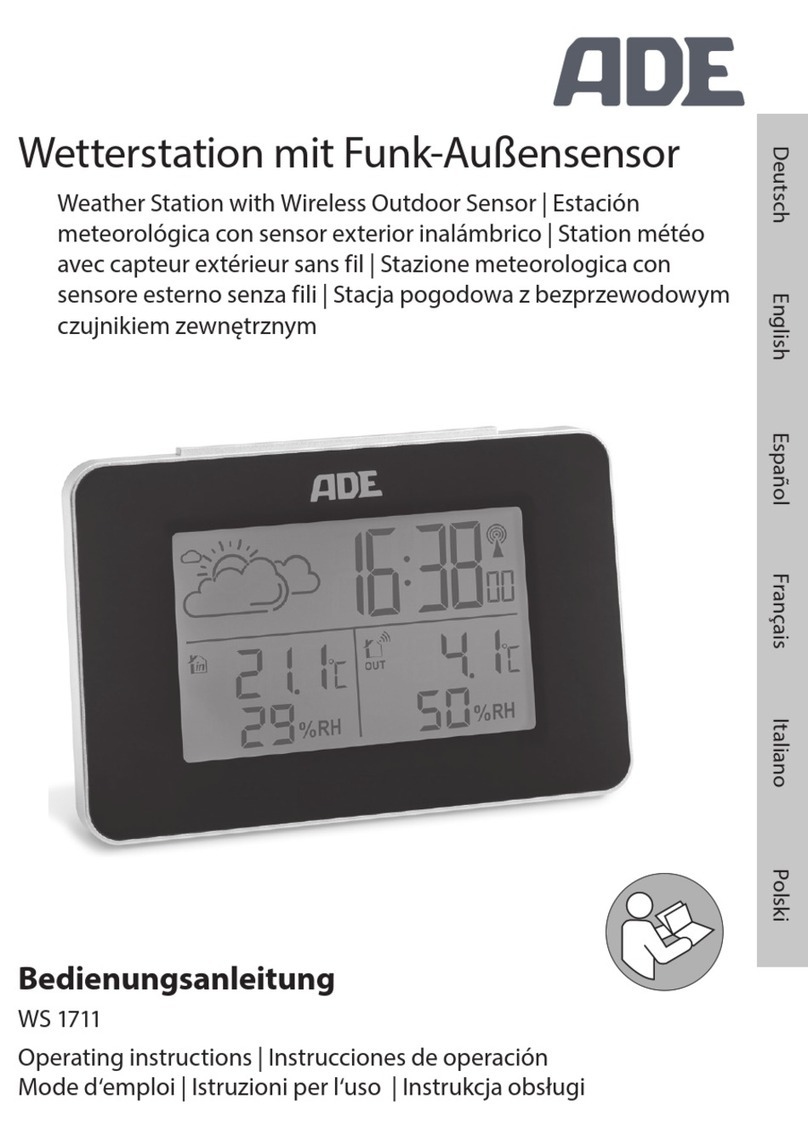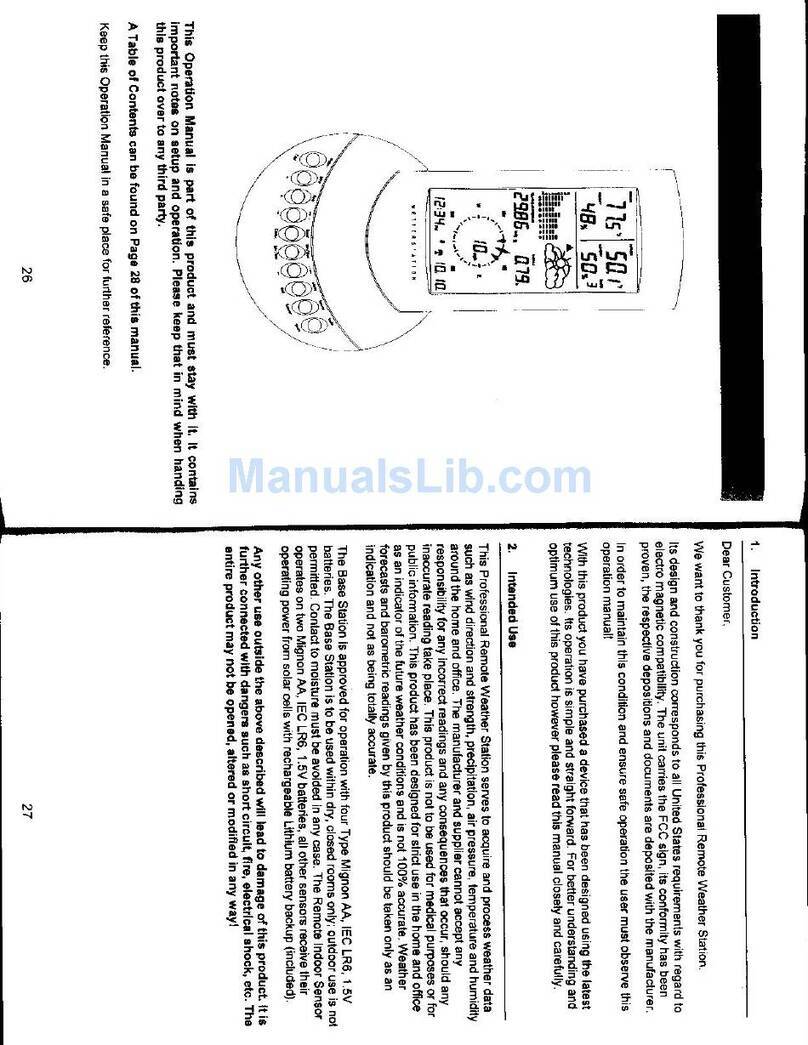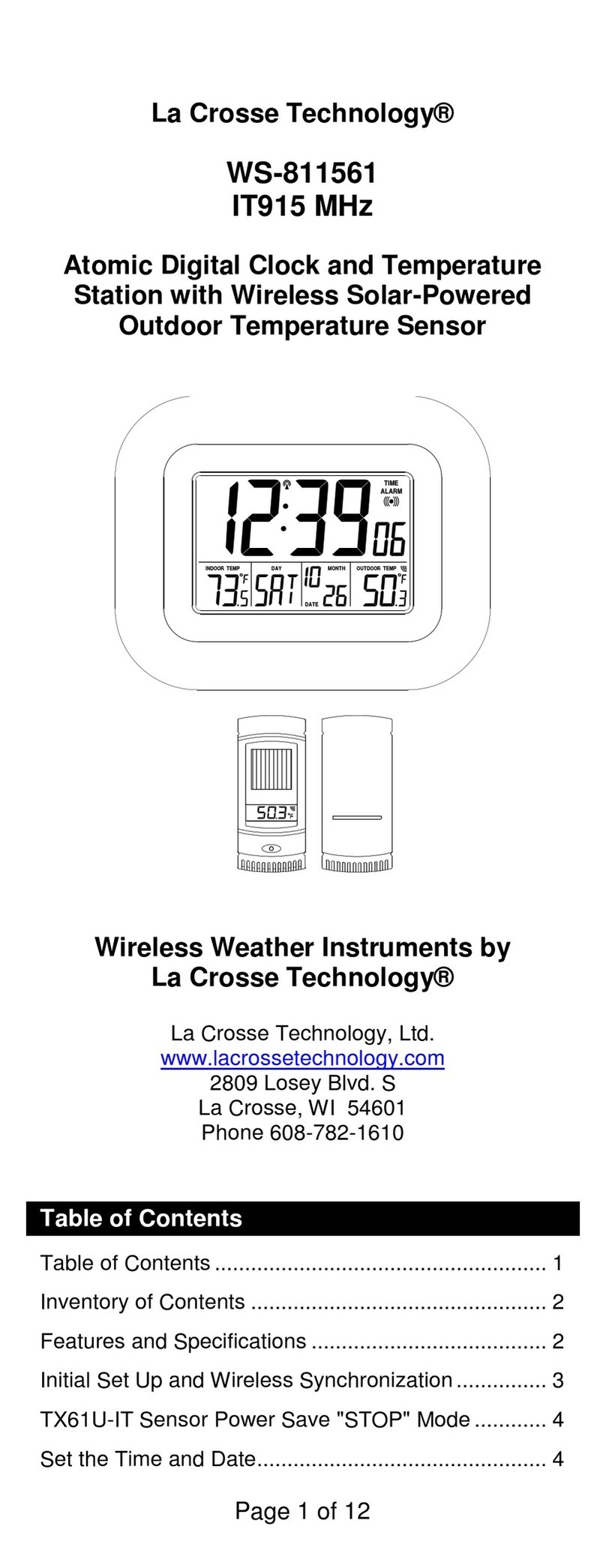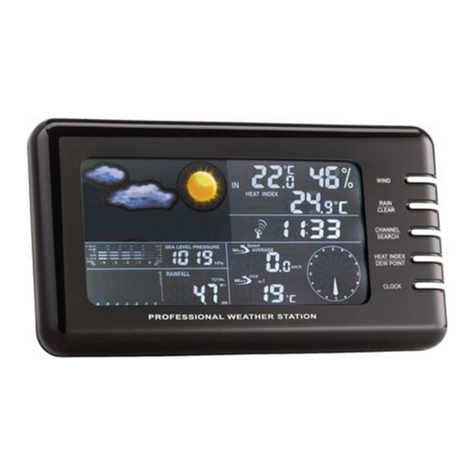1110
CONNECT - Funk-Wetterstation
CONNECT - Funk-Wetterstation
• Drücken Sie die MIN / MAX Taste noch einmal.
• Die niedrigste Temperatur für innen seit der letzten Rückstellung wird angezeigt.
• Drücken Sie die MIN / MAX Taste noch einmal.
• Die höchste Temperatur für außen seit der letzten Rückstellung wird mit Uhrzeit angezeigt.
• Drücken Sie die MIN / MAX Taste noch einmal.
• Die höchste Temperatur für außen seit der letzten Rückstellung wird mit Datum angezeigt.
• Drücken Sie die MIN / MAX Taste noch einmal.
• Die niedrigste Temperatur für außen seit der letzten Rückstellung wird mit Uhrzeit angezeigt.
• Drücken Sie die MIN / MAX Taste noch einmal.
• Die niedrigste Temperatur für außen seit der letzten Rückstellung wird mit Datum angezeigt.
• Um wieder die Anzeige mit den aktuellen Werten zu erhalten, drücken Sie die MIN / MAX Taste noch einmal.
• Halten Sie die MIN / MAX Taste für zwei Sekunden gedrückt, während auf dem Display die höchsten oder tiefsten Werte angezeigt werden, um die
Werte zu löschen.
8. Einstellung der WeatherHub-Verbindung (nur nutzbar mit einem WeatherHub-System)
• Sie können die Basisstation mit dem Gateway aus dem System „WeatherHub” verbinden. Ihre Daten werden dann per Funk über das Gateway-
Modul und das Internet direkt an einen Server übertragen. Mit Ihrem Smartphone können Sie diese Informationen jederzeit abrufen.
• Öffnen Sie die WeatherHub-App, es wird die Übersicht angezeigt. Tippen Sie auf „Neuen Sensor hinzufügen"”und scannen Sie den QR Code auf
der Rückseite der Basisstation.
• Weitere Informationen und eine ausführliche Beschreibung finden Sie unter www.tfa-dostmann.de/weatherhub
9. Aufstellen und Befestigen der Basisstation und des Senders
• Suchen Sie im Freien einen schattigen, niederschlagsgeschützten Platz für den Sender aus. (Direkte Sonneneinstrahlung verfälscht die Messwer-
te und ständige Nässe belastet die elektronischen Bauteile unnötig).
• Stellen Sie die Basisstation im Wohnraum auf. Vermeiden Sie die Nähe zu anderen elektrischen Geräten (Fernseher, Computer, Funktelefone) und
massiven Metallgegenständen.
• Prüfen Sie, ob eine Übertragung der Messwerte vom Sender am gewünschten Aufstellort zur Basisstation stattfindet (Reichweite Freifeld bis zu
100 Meter, bei massiven Wänden, insbesondere mit Metallteilen kann sich die Sendereichweite erheblich reduzieren.)
• Suchen Sie sich gegebenenfalls einen neuen Aufstellort für Sender und/oder Basisstation.
• Ist die Übertragung erfolgreich, können Sie den Sender mit dem Ständer an der Aufhängeöse befestigen oder auf einer glatten Oberfläche hinstellen.
10. Pflege und Wartung
• Reinigen Sie die Geräte mit einem weichen, leicht feuchten Tuch. Keine Scheuer- oder Lösungsmittel verwenden!
• Entfernen Sie die Batterien aus allen Geräten, wenn Sie die Geräte längere Zeit nicht verwenden.
• Bewahren Sie Ihre Geräte an einem trockenen Platz auf.
10.1 Batteriewechsel
• Sobald das Batteriesymbol in der Displayzeile der Außenwerte erscheint, wechseln Sie bitte die Batterien im Sender.
• Sobald das Batteriesymbol in der Displayzeile der Wettervorhersage erscheint, wechseln Sie bitte die Batterien in der Basisstation.
•Achtung: Bei einem Batteriewechsel muss der Kontakt zwischen Sender und Basisstation wieder hergestellt werden – also Batterien in alle Geräte
neu einlegen (Neuinbetriebnahme gemäß Bedienungsanleitung).
• Wie bei jeder Wettervorhersage kann auch bei dieser Wetterstation keine absolute Genauigkeit garantiert werden. In Abhängigkeit von den unter-
schiedlichen Einsatzorten, für die das Gerät entwickelt wurde, ist mit einer Vorhersagegenauigkeit von etwa 75% zu rechnen. So wird das Gerät in
Gegenden mit häufig plötzlich wechselnden Wetterlagen (z.B. von sonnig zu regnerisch) genauer arbeiten als in Gegenden mit geringen und selte-
nen Wetteränderungen (z.B. meist sonnig).
7.3.2 Wettertendenzanzeige
• Die Wettertendenzanzeigen in Pfeilform arbeiten im Zusammenhang mit den Wettervorhersagesymbolen. Zeigt ein Pfeil nach oben, bedeutet dies
einen Luftdruckanstieg und somit eine zu erwartende Wetterbesserung. Zeigt ein Pfeil nach unten, sinkt der Luftdruck und eine Wetterverschlech-
terung ist zu erwarten.
• Zieht man dies in Betracht, kann man ersehen, wie sich das Wetter verändert hat und welche Veränderungen zu erwarten sind. Zeigt die Tendenz-
anzeige z. B. nach unten bei gleichzeitiger Anzeige der Symbole von Sonne und Wolken (wolkig mit sonnigen Abschnitten), dann fand die letzte
registrierte Wetteränderung während einer sonnigen Periode statt (nur das Symbol sonnig). Da die Tendenzanzeige nach unten zeigt, folgt daraus
für die nächste Wetteränderung das Symbol Wolken mit Regen.
Hinweis:
• Hat die Wettertendenzanzeige eine erste Luftdruckänderung registriert, dann bleibt sie ständig auf dem LCD-Bildschirm sichtbar.
7.3.3 Luftdruckverlauf
• Die rechte Seite der zweiten Sektion des LCD-Bildschirms zeigt die Balkengrafik der Luftdruckhistorie.
• Die Balkengrafik zeigt den statistischen Luftdruckverlauf über die letzten 12 Stunden in 5
Schritten zum Zeitpunkt 0h, -3h, -6h, -9h und -12h an. Der Zeitpunkt “0h” repräsentiert den
gespeicherten Luftdruckwert der aktuellen vollen Stunde. Die Balken stellen die Luftdruckwer-
te in “hPa” (0, ±1, ±3, ±5) zu den entsprechenden Zeitpunkten dar. Die “0” in der Skalenmitte
entspricht dem aktuellen Luftdruck und jede Abweichung (±1, ±3, ±5) zeigt an, wie hoch oder
niedrig der zurück liegende “hPa”-Wert im Vergleich zum aktuellen Luftdruck war.
• Steigen die Balken an, so bedeutet dies eine durch steigenden Luftdruck verursachte Wetter-
besserung. Fallende Balken bedeuten sinkenden Luftdruck und damit eine vom aktuellen Zeit-
punkt “0h” zu erwartende Wetterverschlechterung.
Hinweis:
• Wird die Wetterstation von einem Ort an einen anderen verlegt, der bedeutend höher oder tiefer liegt als der ursprüngliche Standort (zum Beispiel
vom Erdgeschoss in die oberen Stockwerke eines Hauses), so sollten die während der ersten 12 - 24 Stunden angezeigten Werte ignoriert wer-
den. Dadurch wird gewährleistet, dass die Wetterstation die Verlegung nicht als Änderung des Luftdrucks wahrnimmt, wenn es sich in Wirklich-
keit nur um eine Änderung der Höhe des Standorts handelt.
Achtung: Die Wettervorhersage wird nicht auf die WeatherHub App übertragen.
7.4 Temperatur und Luftfeuchtigkeit
7.4.1 Höchst- und Tiefstwerte
• Drücken Sie die MIN / MAX Taste im Normalmodus.
• Die höchste Temperatur für innen seit der letzten Rückstellung wird angezeigt.
TFA_No. 35.1143_Anleitung 28.11.2016 18:18 Uhr Seite 6
